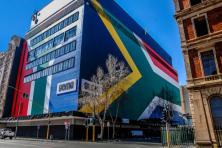
This article is part of The Road through Paris, a series leading up to the COP21 international climate talks in December. It is also the third in an eight-week blog series from New Energy Cities detailing the state of the low-carbon city movement.
In the early days of climate action, urban plans to reduce carbon frequently suffered from the laundry list syndrome: outlining catalogs of potential strategies without any evidence of how those actions would add up to meeting long-term carbon reduction goals. Since then, cities and counties are becoming increasingly sophisticated about figuring out how to achieve their goals, and are developing clean energy transition plans to do it.
The first step is to map out—and show stakeholders—how potential actions can collectively meet an overall carbon reduction goal:
- In 2013, Santa Monica, CA (pop. 92,000) produced a 15x15 Climate Action Plan—15 action items to make a 15% reduction below 1990 levels by 2015—that outlined a simple, clear checklist of climate actions for the city to take that would collectively meet the community-wide reduction goal. City staff focused the plan on short-term strategies that would help the community limit anticipated growth in emissions and get on a path to deeper reductions in 2030 and 2050.
- In 2014, the King County-Cities Climate Collaboration (pop. 1,500,000) commissioned a carbon wedge analysis from Climate Solutions’ New Energy Cities program to depict what it would take for King County to cut carbon in half by 2030 (50x30). This analysis formed the basis of the K4C’s joint county-city climate commitments, which are specific, time-based pathways that add up to the 50x30 goal—including a target of sourcing 90% of its electricity countywide from renewables by 2030.
Next, a community needs to plan its transition to clean energy, with specific partners and projects:
- In 2010, Bristol, UK (pop. 442,500) developed a Climate Change and Energy Security Framework “to translate carbon targets into energy efficiency and renewables targets for 2020 and 2050,” which earned Bristol the European Union Green Capital award in 2015. In July 2015, Bristol approved a proposal for the city to expand its energy service company community-wide to residents and businesses—a groundbreaking move in the U.K., where private utilities provide the lion’s share of energy. City control over the energy service has enabled Bristol to operate its own 2.5-MW wind farm on city land; install rooftop solar on over 30 schools; and establish district heating networks. The city further plans to generate 1 GW of solar by 2020 through purchase agreements with community organizations that operate in municipal buildings.
- In response to Mayor Gavin Newsom’s 2010 call for 100% renewable energy, San Francisco (pop. 837,000) convened a Renewable Energy Task Force of expert staff and citizens for a year and a half to study in-depth what it would take for the city to achieve that goal. The city’s Renewable Energy Program Manager and the C40 Climate Leadership Group Director of City Programs co-led the task force, with a diverse group of utility and clean energy experts, environmental and community advocates, and labor, with philanthropic support from the Sidney E. Frank Foundation. The task force found that, in addition to energy efficiency and local renewable installations, San Francisco needed community choice aggregation—a local program to purchase power outside of the typical private utility—to meet its clean energy goal. (The San Francisco Public Utilities Commission now runs that program, CleanPowerSF.)
- In 2013, Sydney, Australia’s (pop. 4,300,000) Chief Development Officer of Energy and Climate Change Allan Jones developed the city’s Decentralized Energy Master Plan for Renewable Energy, one of five interconnected blueprints for infrastructure planning with a target year of 2030. Jones aims to use 100% renewable energy for power, heating, and cooling, with conventional renewables providing 30% of the city’s electricity, and the other 70% coming from biomass-based combined heat, power, and cooling. Notably, the city’s plan found that renewable gas available from within 250 kilometers (155 miles) of the city limits could replace 100% of the natural gas used to supply the city’s planned network, producing virtually carbon-free energy.
Jones commented, “It’s important to start off with a 100% renewable energy policy to discipline you, to force you, to work out what components of the different sorts of renewable energy… to do the correct calculations… and you cannot do that with a random selection of solar, wind, or other technologies. They have to work together.”
Jurisdictions new to carbon reduction and clean energy don’t have to reinvent the wheel. In 2014, Innovation Network for Communities (IN4C) produced The Road to 2050: 80x50 Strategy Maps for Carbon-Neutral Cities, a report that summarizes the most common carbon reduction strategies of U.S. communities committed to 80% reduction by 2050 (80x50), and recommends how to structure the strategies over time. IN4C will soon release a similar roadmap document for cities to achieve carbon neutrality.
With early leaders and partner organizations to show the way, urban officials and their staff are figuring out to achieve low-carbon energy goals.





